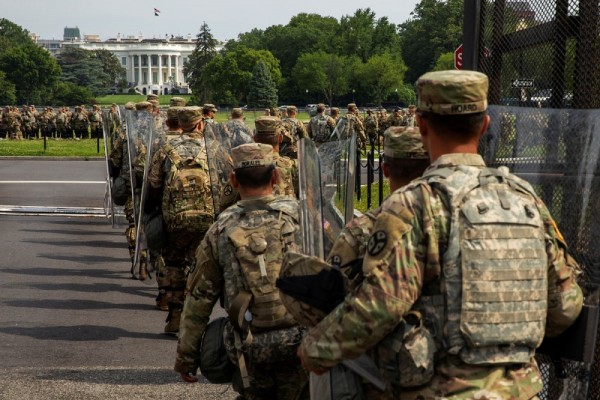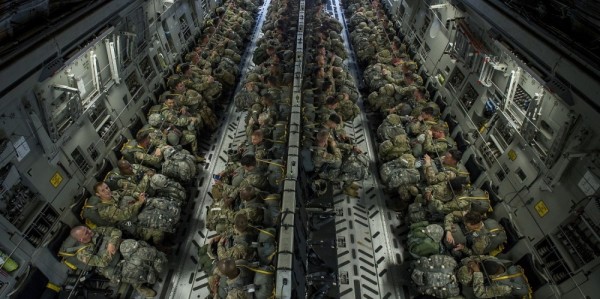For several years, the U.S. Army has been considering how to better prepare its leaders and formations for large-scale combat operations (LSCO) against peer and near-peer threats. As an Army officer with over four years in Iraq, Afghanistan, and the broader Middle East, I appreciate the challenges of transitioning a force well-trained and educated in counter-insurgency operations (COIN) to one capable of fighting and prevailing against threats like Russia and/or China. The Maneuver Captains Career Course (MCCC) at Fort Benning, Georgia, the Army’s premier school for educating its officers in tactics and planning, has made revising its course curriculum to fully teach LSCO and competition with China and Russia its top priority. MCCC is building a fully-aligned LSCO curriculum by redefining our operational environment, focusing on the division (DIV) as the unit of action, and considering expansion opportunities within multi-domain operations (MDO) to develop the Army’s next generation of maneuver leaders to fight and win in LSCO.
Identifying the problem
In January 2021, the Maneuver Center of Excellence (MCoE) Commanding General, Major General Patrick Donahoe, directed MCCC to prioritize revising and reorienting its curriculum to better reflect LSCO and competition with China and Russia. As the proponent for MCCC, my team and I thoroughly analyzed our curriculum and found that while MCCC had certainly made incremental transitions toward teaching LSCO, many vestiges from our experiences in Iraq and Afghanistan stubbornly remained in the curriculum.
Several of our key scenarios were still geographically located in Iraq or Western Asia, tethering ourselves physically and cognitively to the Middle Eastern region and its arid terrain. Furthermore, we found the adversaries in our training scenarios were outdated and varied considerably, ranging from insurgent and/or hybrid groups, to barely near-peer militaries. Conspicuously missing were belligerents with the capabilities of today’s Russian and Chinese militaries. Finally, MCCC instruction oriented on the brigade combat team (BCT) as the unit of action with an abundance of air assets and enablers operating in a largely uncontested environment – again, not reflecting the real competition with peers and near-peer threats we should expect. For MCCC, our path to adopting a fully LSCO-aligned curriculum would begin with redefining the operational environment our instruction was meant to center on.

Redefining the operational environment
- Location. Maj. Gen. Donahoe’s consistent guidance when discussing MCoE’s LSCO transition has been “east of the Vistula, north of the Han.” A simple phrase providing clear direction: focus our training scenarios on East Asia and Eastern Europe – those likely places we might confront Chinese and Russian threats. After considerable work over the last year from MCCC instructors and the Army’s Combined Arms Center, the physical terrain of MCCC’s instruction is out of Western Asia and largely east of the Vistula and north of the Han. We retained some local scenarios to allow students the opportunity to walk the ground and appreciate the terrain from a tactical perspective not always gained from a map. However, all other scenarios now take place outside of the deserts of Iraq and focus on how to fight and win in terrain ranging from the dense forests of the Baltics to the mountainous terrain of East Asia.
- Threat. In June 2021, Chief of Staff of the Army General McConville stated, “The Army must understand the threat posed by China to the same level that we understood the Soviets.” To my knowledge, MCCC (and MCoE for that matter) had never incorporated a threat based on the Chinese Army into its training and educational scenarios. This is no longer the case. To drive change and educate cadres across the MCoE, MCCC designed a foundational block of instruction derived from ATP 7-100.3 Chinese Tactics that introduces all students to the Chinese Army, its structure, and aspects of how we assess their fighting capabilities at the tactical level. In addition to relocating our scenarios to East Asian and Eastern European battlefields, MCCC rebuilt our scenario threats to reflect the modernizing armies of China and Russia while remaining decisive action training environment (DATE) compliant. Now, over 60% of MCCC’s scenarios feature DATE threat actors resembling the Chinese formations described in ATP 7-100.3 Chinese Tactics. The remaining 40% of our tactical scenarios are based on the current Russian military, and MCCC plans to design a similar foundational block on the Russian Army upon the publication of ATP 7-100.1 Russian Tactics. There is far more work to be done in educating students on Chinese and Russian tactics to a level at which we understood the Soviets, and this represents a considerable area of expansion for MCCC in 2022.
- Employing Enablers in a Contested Environment. As a platoon leader in Iraq, I credit two Apache attack helicopters with saving my life, and I knew I could always rely on air support being close by and highly responsive. In an LSCO environment, the days of helicopters loitering over small units, unmanned aircraft systems (UAS) soaking targets uncontested for 48 hours, and firing mortars and artillery without regard for their proximity to command posts, assembly areas, and logistics nodes are gone. Similarly, our expectation of complete air supremacy and not worrying about more than a small UAS dropping a 40mm grenade on top of us is unrealistic. This revised operational environment that MCCC is building into its scenarios is intended to teach students to account for a threat with accurate and even overmatched fires, air defense assets at nearly every echelon, aircraft capable of striking friendly units, near-constant observation by enemy UAS, and the capabilities to broadly disrupt our communications systems. We are trying to impart to our students that the resources they will receive are 1) more finite in terms of time allocation and quantity, 2) susceptible to many forms of enemy contact, and 3) must be employed thoughtfully to prevent easy enemy predation and enable preservation for future friendly use.

- Scope, Size, and Intensity. MCCC’s foundational urban attack scenario was an excellent example of why we had to do more than just change locations and threats in our tactical scenarios. We had to reconsider the scope, size and intensity of our exercises to ensure they reflected the realism of combat operations within an LSCO environment. When I peeled back the layers of our urban attack scenario, I found an operation reminiscent of my days in Baghdad – a unit alone and unafraid in a city, retaking a compound (police station) seized by an insurgent group, with U.S. forces providing an outer cordon while host-nation forces entered and cleared the objective. This did not feel like LSCO in an urban environment. We needed to start over and build something more akin to Stalingrad than to Iraq 2009 or Afghanistan 2016.
As an immediate fix, my team completely changed the threat, removed host-nation forces, and allowed for more permissive use of direct and indirect fires. Looking to the future, our new urban scenario being constructed will revolve around a higher density of units fighting with combined arms as part of a larger division operation. The scenario will focus on key terrains like bridges, rail hubs, airfields, and major lines of communication needed to continue the advance — all while facing a very lethal peer threat. The intent is to create a scenario that forces students to think through what makes urban operations so difficult: canalizing terrain that breaks up formations, degraded capabilities of many weapons systems, difficulties in massing combined arms, and higher casualties, resource consumption, and command and control challenges. Considerations and mission variables such as these will push our students beyond COIN tactics and will provide the foundation and framework to apply the proper scope, size, and intensity to our LSCO scenarios.
Orienting on the Division as the unit of action
When students graduate from MCCC, few go directly into company or troop command. Most will find themselves planning tactical operations as part of a BCT or battalion (BN) staff. As such, over a third of MCCC’s 22+ week curriculum aims to fuse the foundational tactics learned in MCCC’s first 11 weeks with planning BCT and BN-level operations using the Army’s military decision-making process (MDMP). As of late 2019, the BCT remained the unit of action for MDMP training and education at MCCC while the rest of the Army was adjusting to LSCO and the DIV as the unit of action. At MCCC, it was time to expose our students to the DIV as the unit of action and also an overall adjustment to our instructional approach for MDMP.
- Exposure to the Division. To be clear, the DIV as the Army’s unit of action does not mean young captains should execute DIV-level planning; I still think that is for our majors at the Command and General Staff Officers Course. However, given that nearly all our students will serve on a BCT or BN staff, it is imperative they are exposed to DIV-level operations to gain an understanding of how their BCT or BN is nested within a broader mission. In our 2019 approach, students had little to no exposure to the DIV, let alone a well-developed DIV plan. So we changed. In collaboration with the Logistics and Military Intelligence Captains Career Courses, we built a full DIV operations order and plan to govern MDMP instruction and education at MCCC. In June 2021, CAC even provided MCCC with a DIV-level Baltic scenario as part of their Combined Scenario Exercise Program. As of 2021, 100% of MCCC students now conduct the MDMP as part of a DIV as the unit of action in an LSCO environment.
- Adjusting our Training Approach. With a full DIV order in hand, MCCC substantially changed its approach to how student staffs conduct the MDMP and interact with one another. In the past, a student BCT staff would receive a complete BCT order only to digest and reissue that order to student BN staff. The BN staff then conducted the MDMP, leveraging their BCT staff to mainly answer questions and orchestrate BCT-level rehearsals. Many students were not challenged due to a lack of friction between staffs, and no actual BCT-level MDMP occurring (a missed opportunity). Ultimately, there was no meaningful exposure to a synchronized DIV plan. So again, we changed our approach. In short, student BCT staffs now receive a DIV order and start full BCT-level MDMP (developing their own unique plan and thus taking ownership of it) two days ahead of their BN staffs. BNs then initiate the MDMP based on what the BCT staff produces and issues. BCT staffs are exposed to the realistic tensions of their BNs pressing them for information, products, and planning guidance. All staffs gain an appreciation for relationships at echelon, a battle rhythm and sticking to planning timelines, and the benefits of bottom-up refinement during planning. And while this approach is harder and more stressful, it is more realistic. This enhanced approach also produces improved student learning and enables direct exposure to the DIV as the unit of action, all while immersing students in an LSCO environment.
Expansion opportunities in multi-domain operations and cross-domain maneuver
I am more than occasionally asked how MCCC is teaching captains multi-domain operations (MDO) and cross-domain maneuver (CDM). This often leads back to a more fundamental question: what does a young captain need to know about MDO and CDM? It is a good question and I will describe briefly what we teach now and outline some growth opportunities for our curriculum in 2022 to improve our LSCO orientation. In short, MCCC currently focuses on the land and air domains as expected, but it does introduce concepts of the space domain and electro-magnetic spectrum (EMS) in large-group classes and at a surface level in BCT and BN planning.
- Land and Air Domains: At MCCC we prioritize teaching students foundational tactics on how to fight using the Army’s three BCT types at the company level, and progress later in the course to fighting at BN and BCT echelons. Within these echelons, we teach students to effectively synchronize and employ a host of combined arms assets and enablers in concert with their ground maneuver formation. This usually translates to mortars and artillery, fixed and rotary-wing aviation, UAS and other intelligence collection platforms, and engineer assets. While not an exhaustive list (we do touch on all warfighting functions), this captures the majority of combined arms elements our students are learning about and employing in their tactical planning.
- Space Domain and the Electromagnetic Spectrum (EMS): Most formal instruction outside of the traditional land and air domains is concentrated on space and the EMS. Students are introduced to broad concepts and planning considerations and are taught how these can influence their operations on the battlefield. As MCCC does not have the resident expertise to provide detailed instruction in these areas, we leverage experts from across the Army to help us deliver very specific topics such as the space domain.
- MDO and CDM Growth Opportunities: There are several MDO and CDM-related areas MCCC will expand its instruction into regarding competition with China and Russia and LSCO. First, we plan to introduce the cyber domain and cyber-electromagnetic activities (CEMA) as a concept. While students do not need to be experts in cyberspace, a surface-level knowledge of the domain, how the Army thinks about it, and how cyber affects BCT-level operations and below is useful. Furthermore, as the Army fields CEMA capabilities to its BCTs, there is utility in our students’ understanding of how to effectively plan for and employ such assets on the battlefield. Second, we plan to invest more in understanding our own communications and the EMS. Understanding some of the science behind the EMS and our communications, how our competitors like China and Russia compete in the EMS, and how we should respond and operate in this contested environment are all worthy of greater study. As a third example, MCCC will deliver general instruction on air defense artillery (ADA) employment. In the Army, it has been some time since ADA was commonly seen at the BCT level and below. This branch is a feature of MCCC’s LSCO scenarios, and we must educate our maneuver officers to better understand and effectively employ ADA assets in an LSCO environment.
Conclusions
Competition with China and Russia is here to stay for the foreseeable future, and this requires an institutional shift towards better understanding and training for LSCO. As I write this, Russia continues its war in Ukraine, and the United States continues to push more troops and arms to Eastern Europe to bolster our Allies. While transitioning our Army to a fighting force more capable of prevailing in an LSCO contest will not happen overnight, MCoE and MCCC play a vital role in preparing future generations of Army leaders to fight and win the next war. Our key is to remain agile and dynamic in our curriculum and instructional approach, with our foot on the gas – willing to adjust and adapt for the future fight.
+++
Lieutenant Colonel John Dolan is an active duty Army Officer with 17 years of experience and currently runs the Maneuver Captains Career Course at Fort Benning, Georgia. LTC Dolan has primarily served in Armor and Cavalry assignments and has deployed extensively to Iraq, Afghanistan, and the broader Middle East.
The latest on Task & Purpose
- The few, the proud, the drunk: Meet America’s revolutionary yet ‘ungentlemanlike’ troops of 1776
- A rocket mysteriously crashed on the Moon. The military has no idea who sent it
- Fake Navy SEAL ordered to stop being a fake Navy SEAL
- Why the Army refuses to call its new light tank a ‘light tank’
- The Air Force now has a golden F-16
Want to write for Task & Purpose? Click here. Or check out the latest stories on our homepage.








